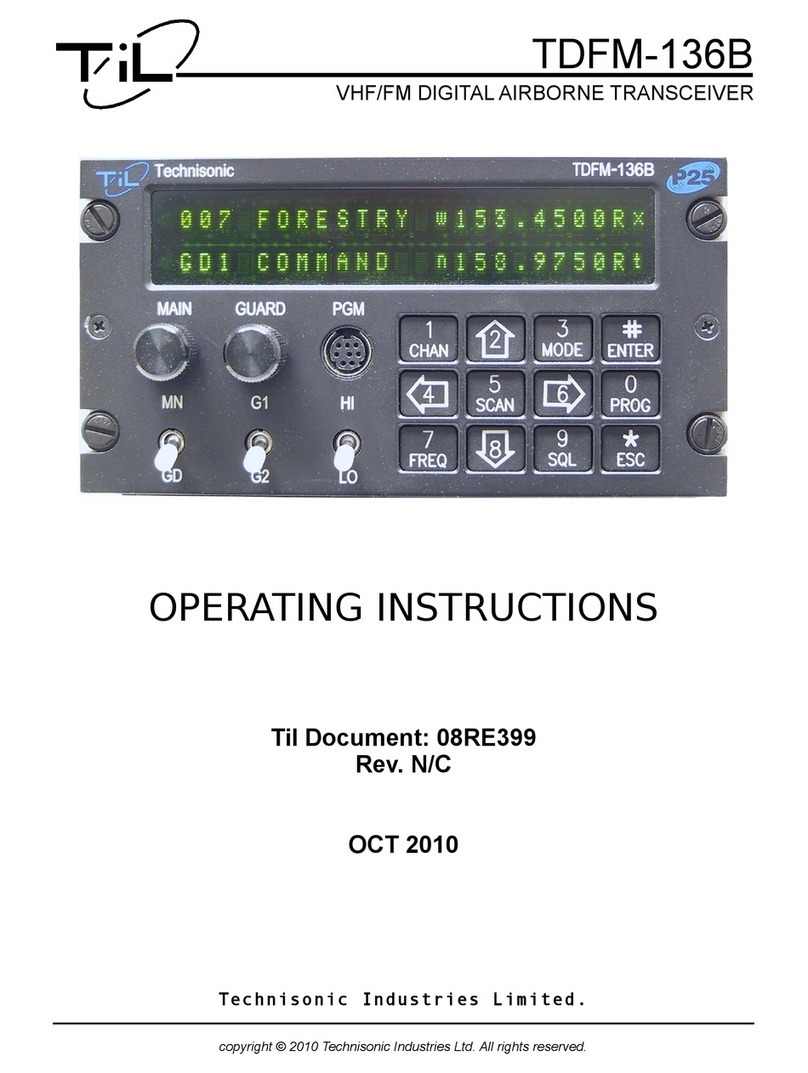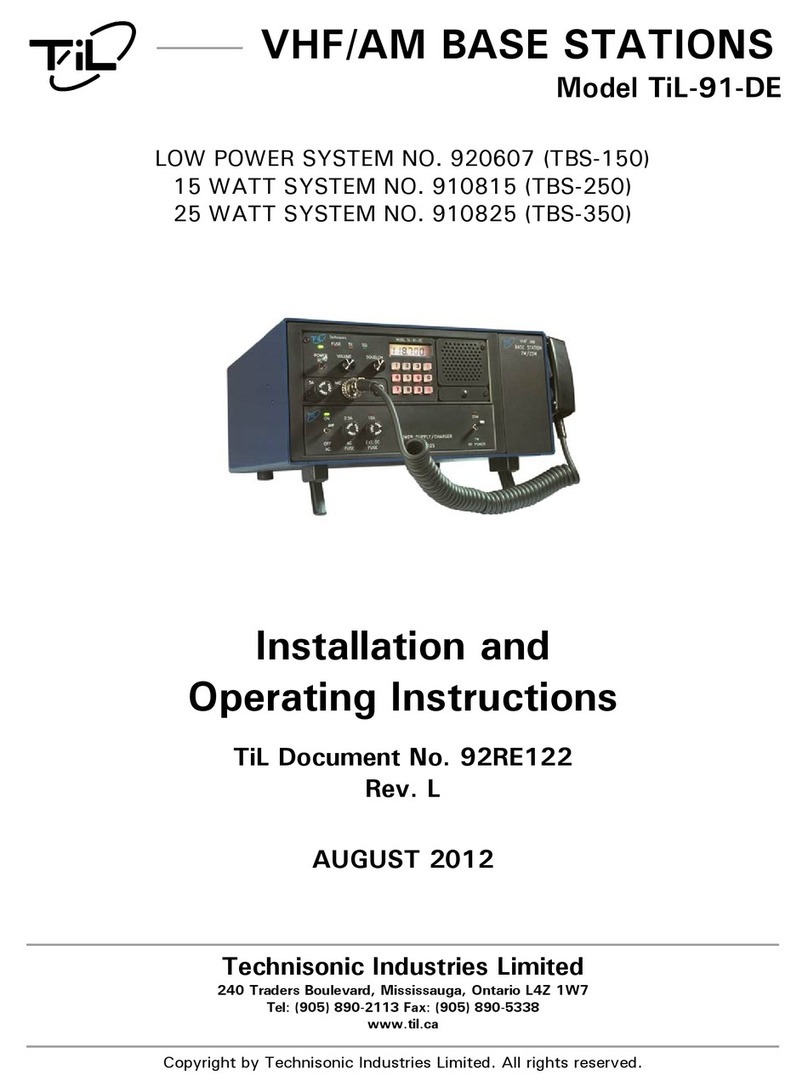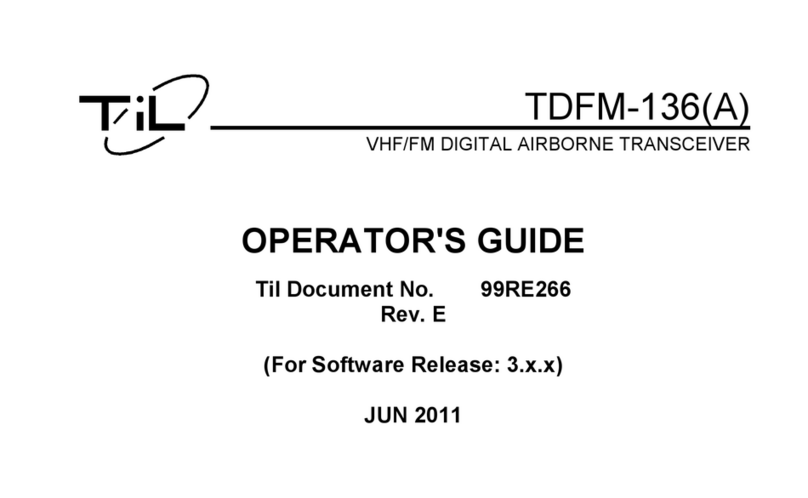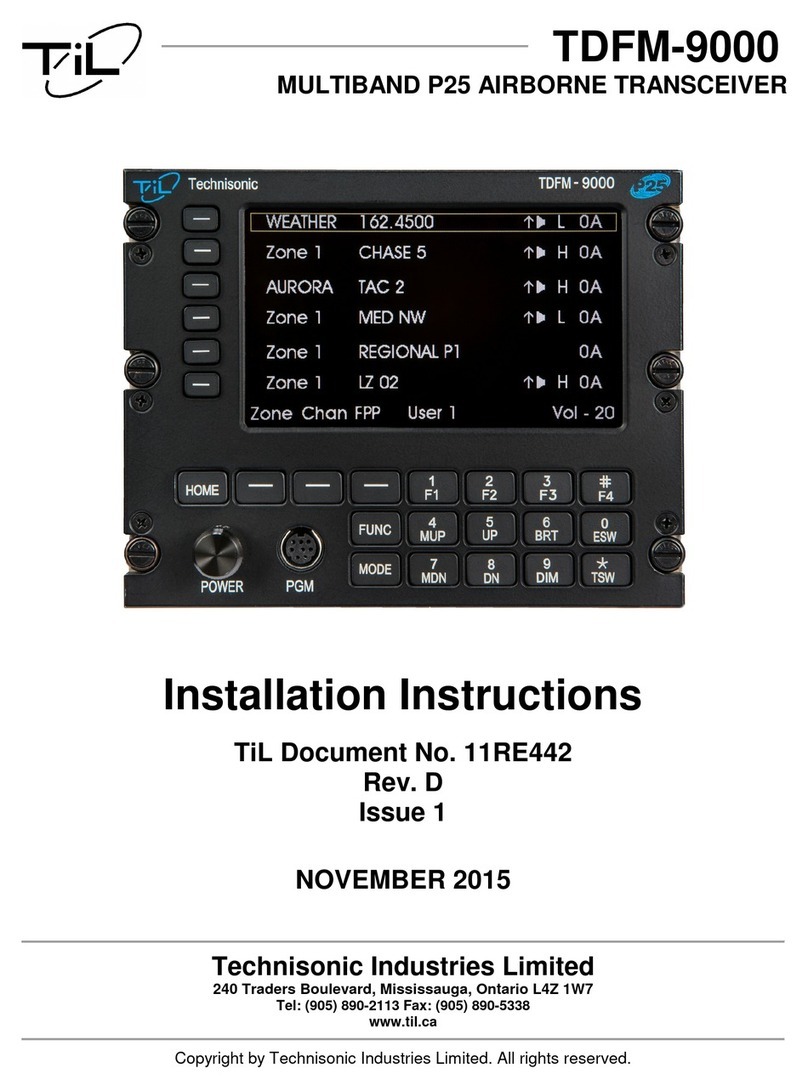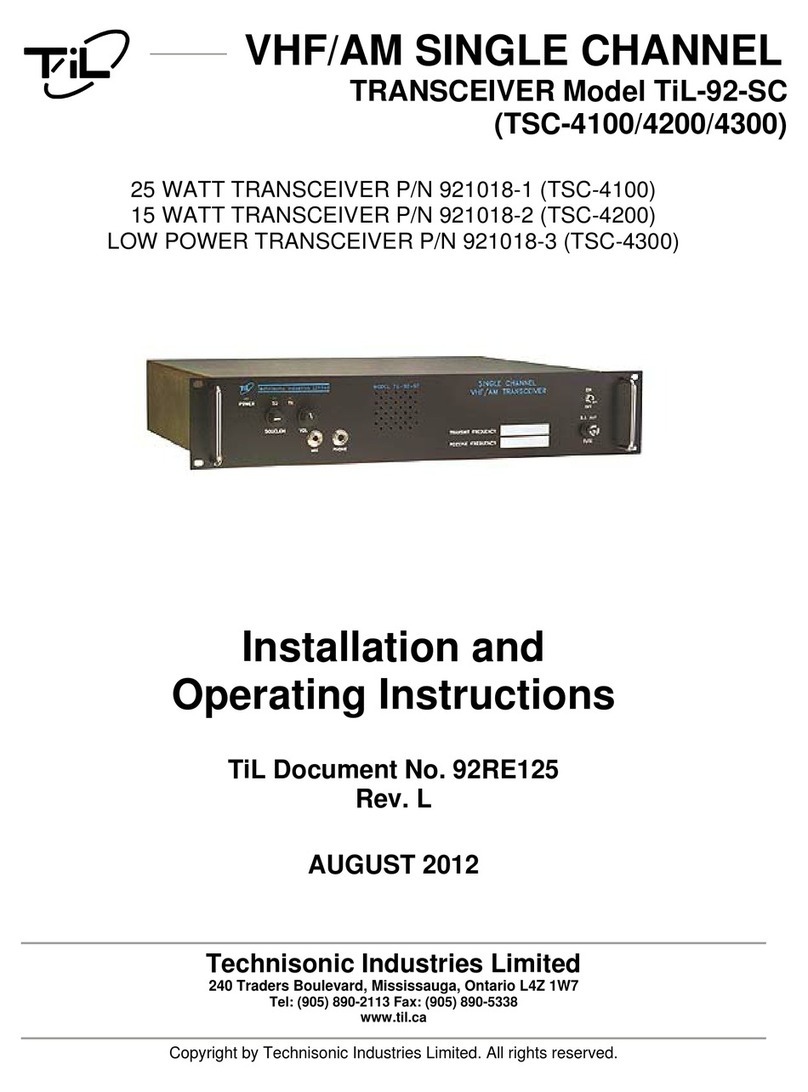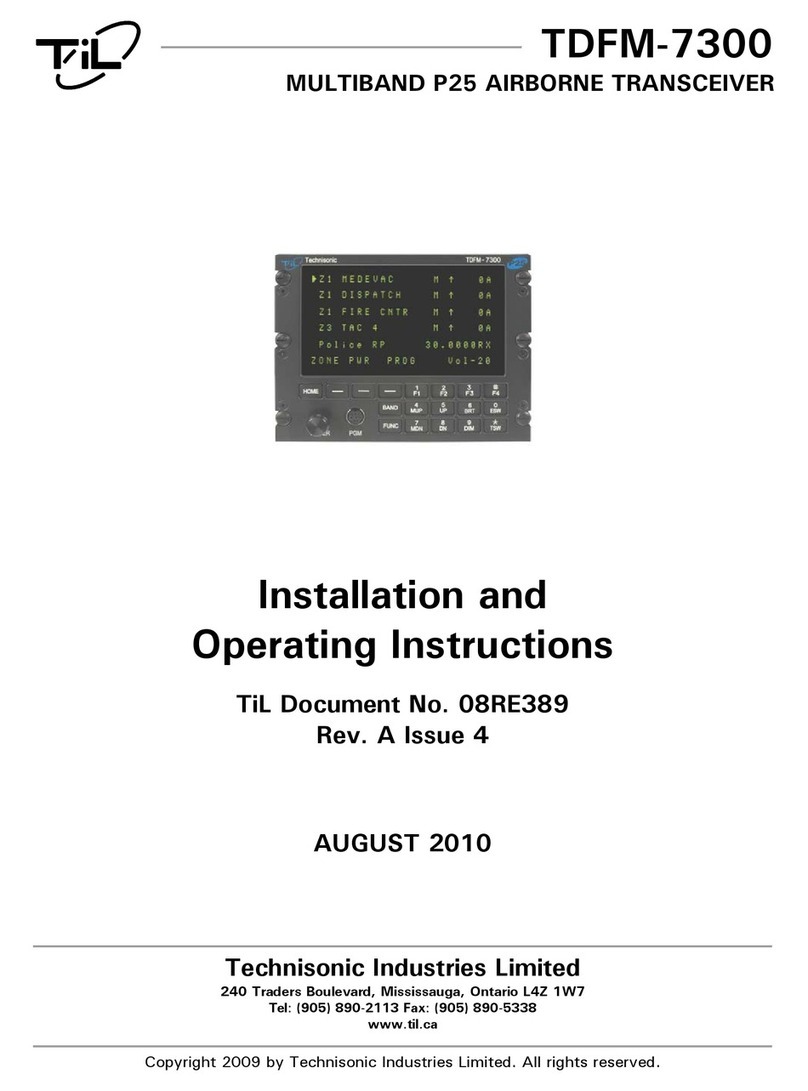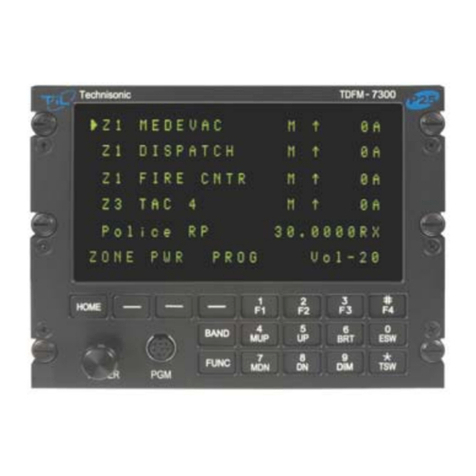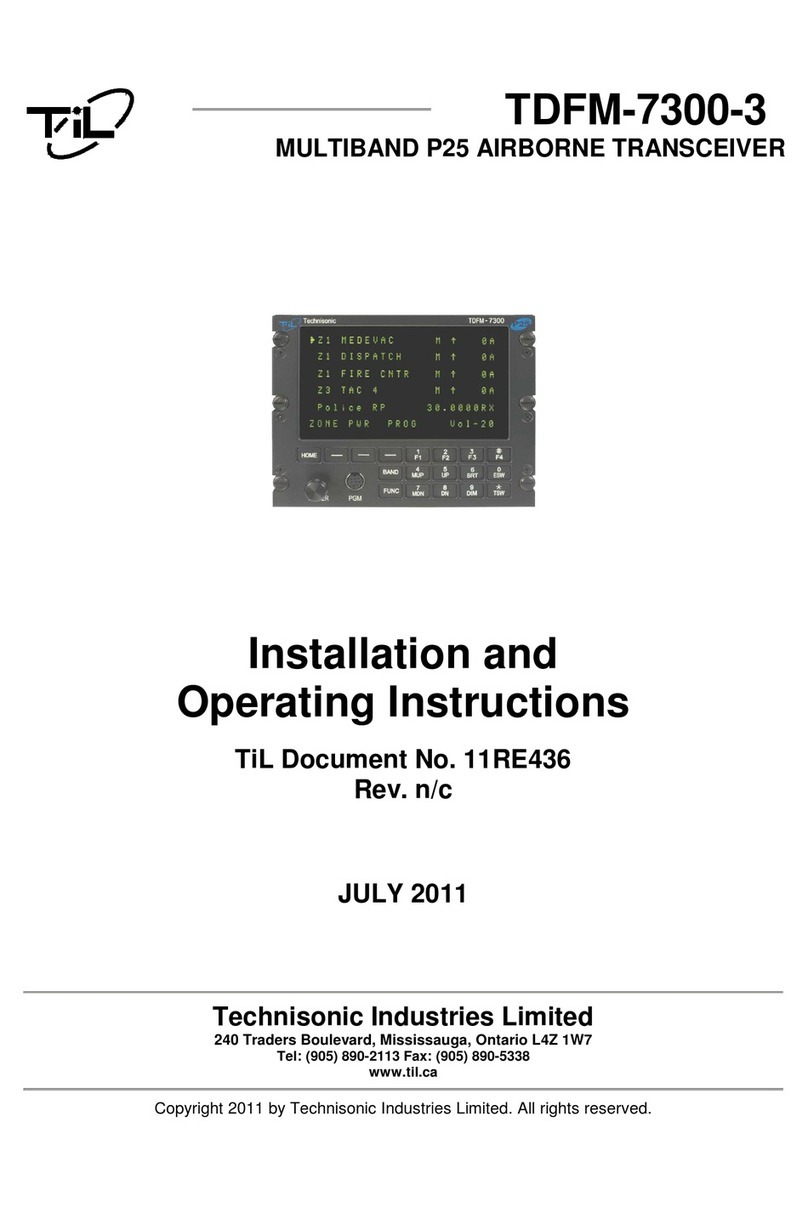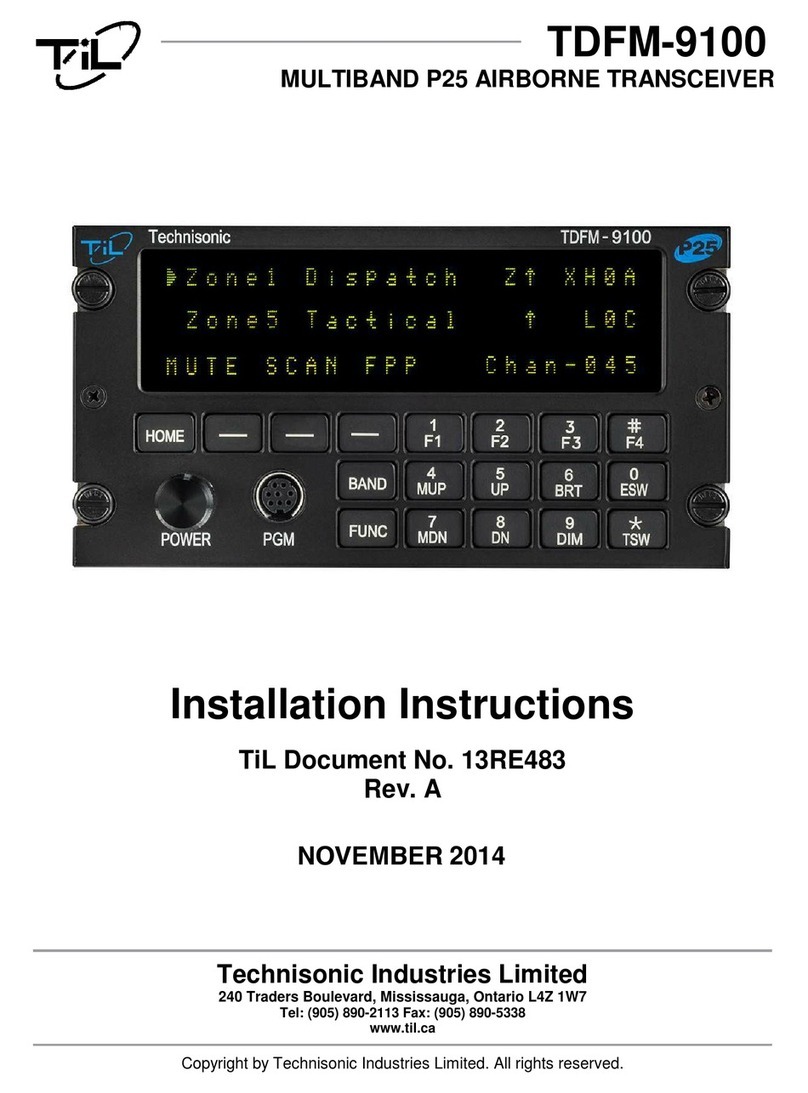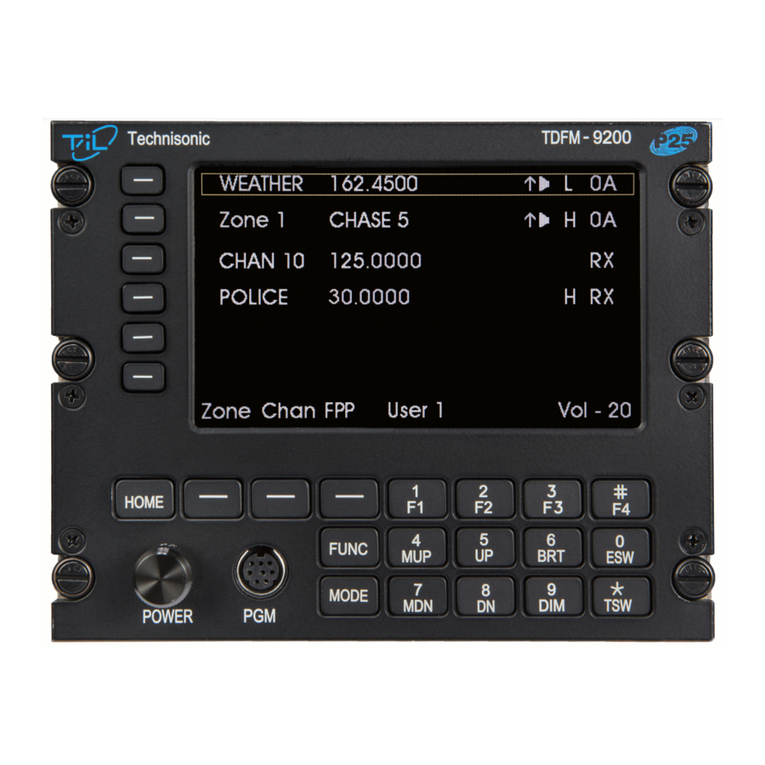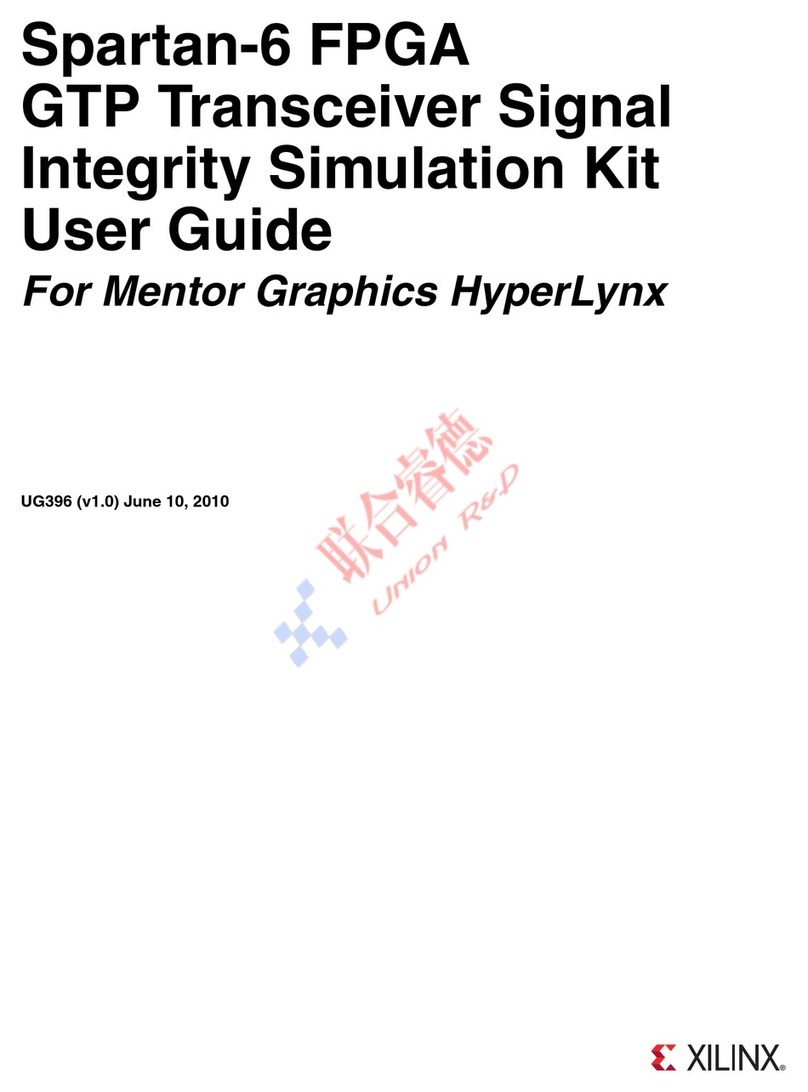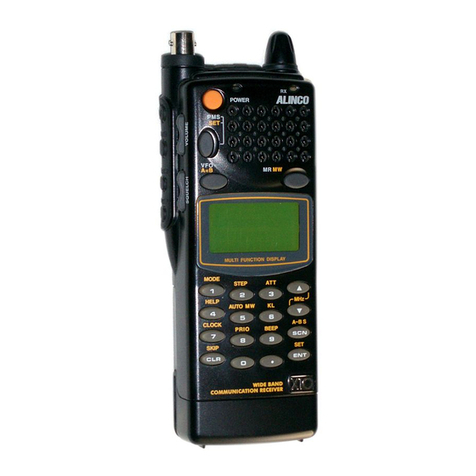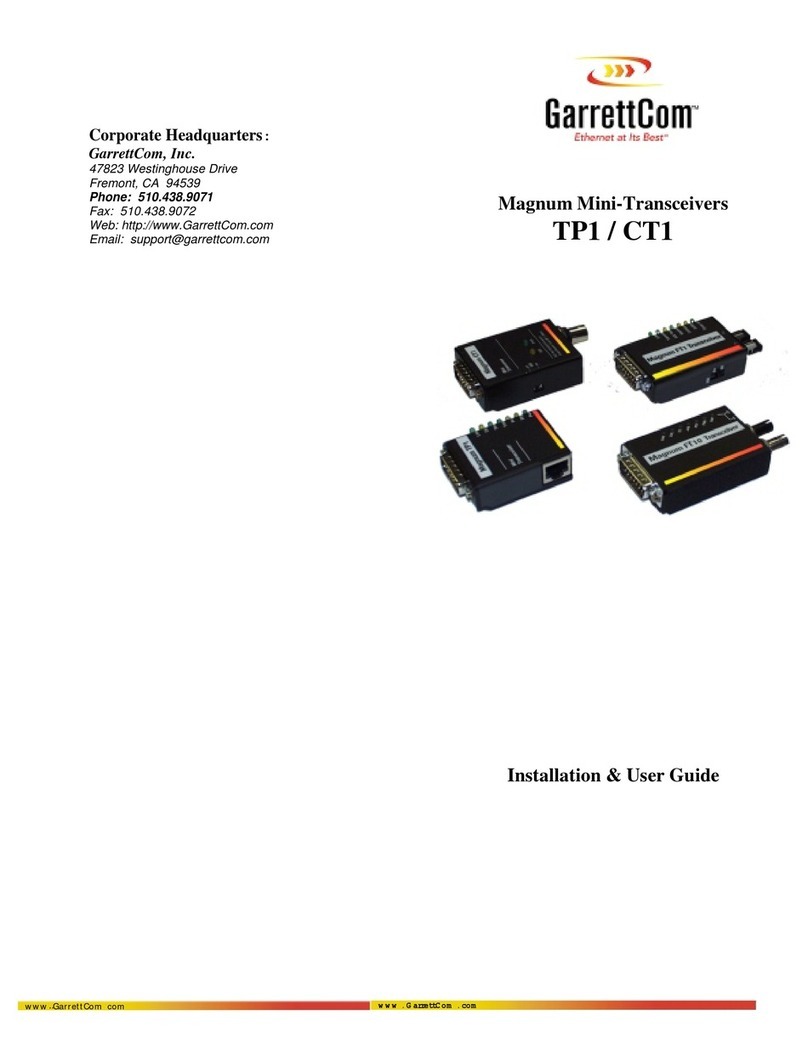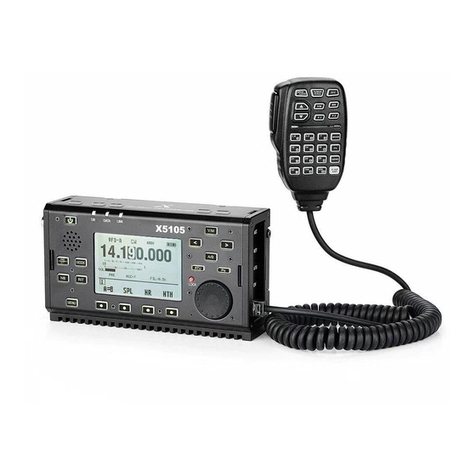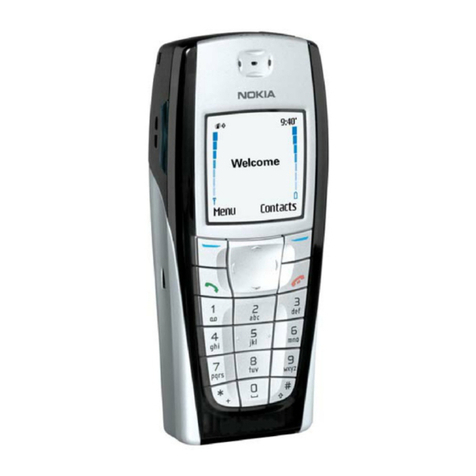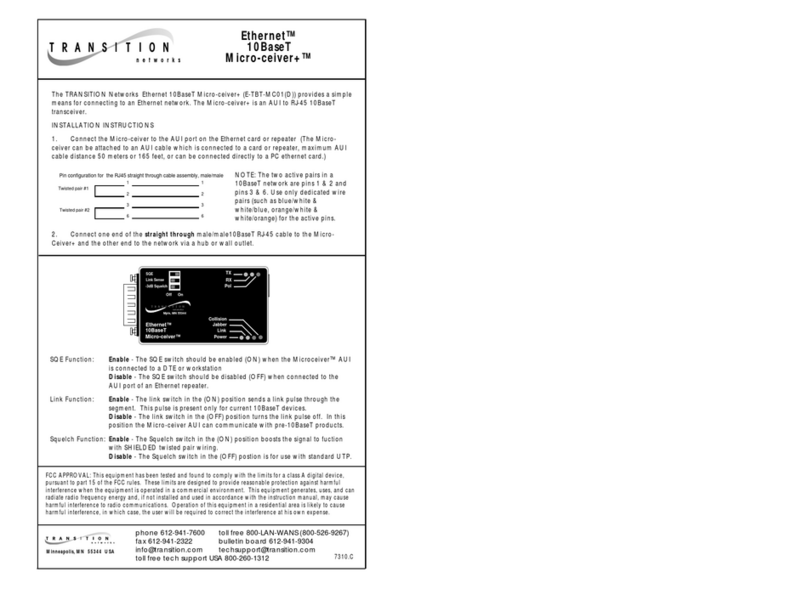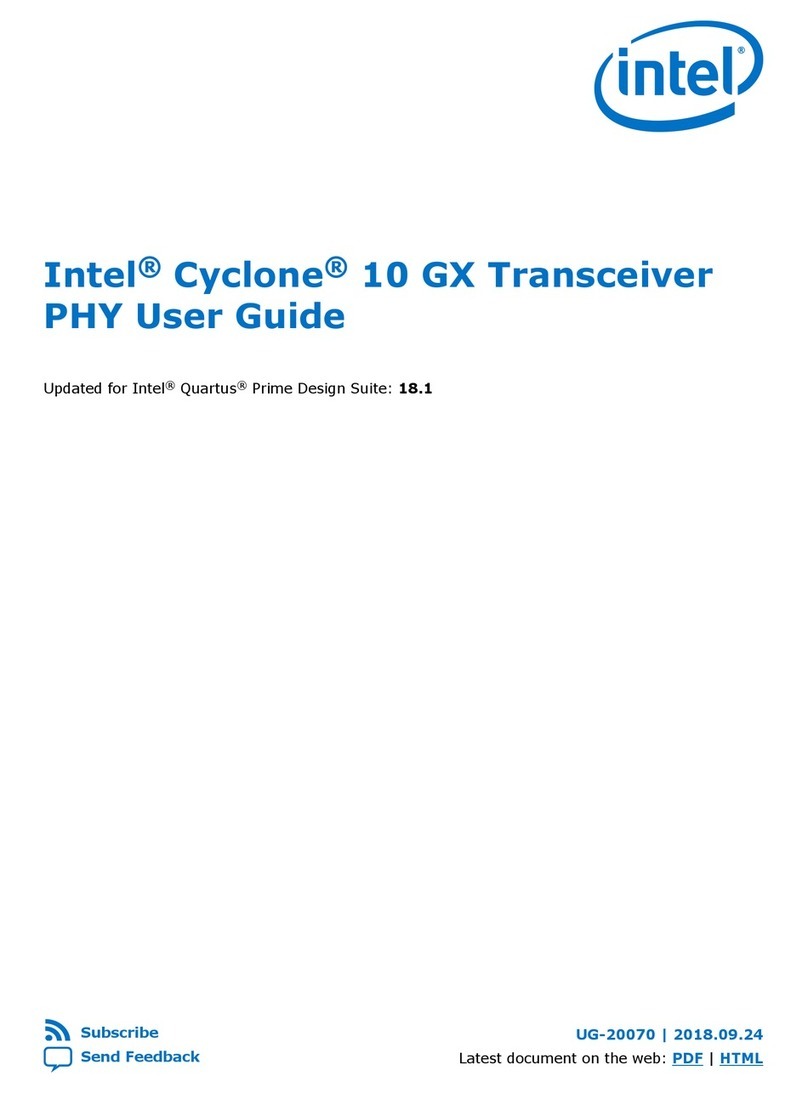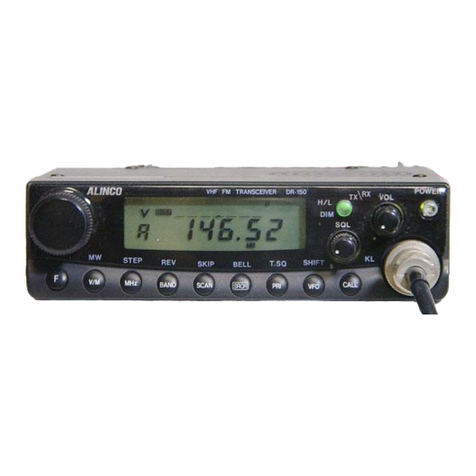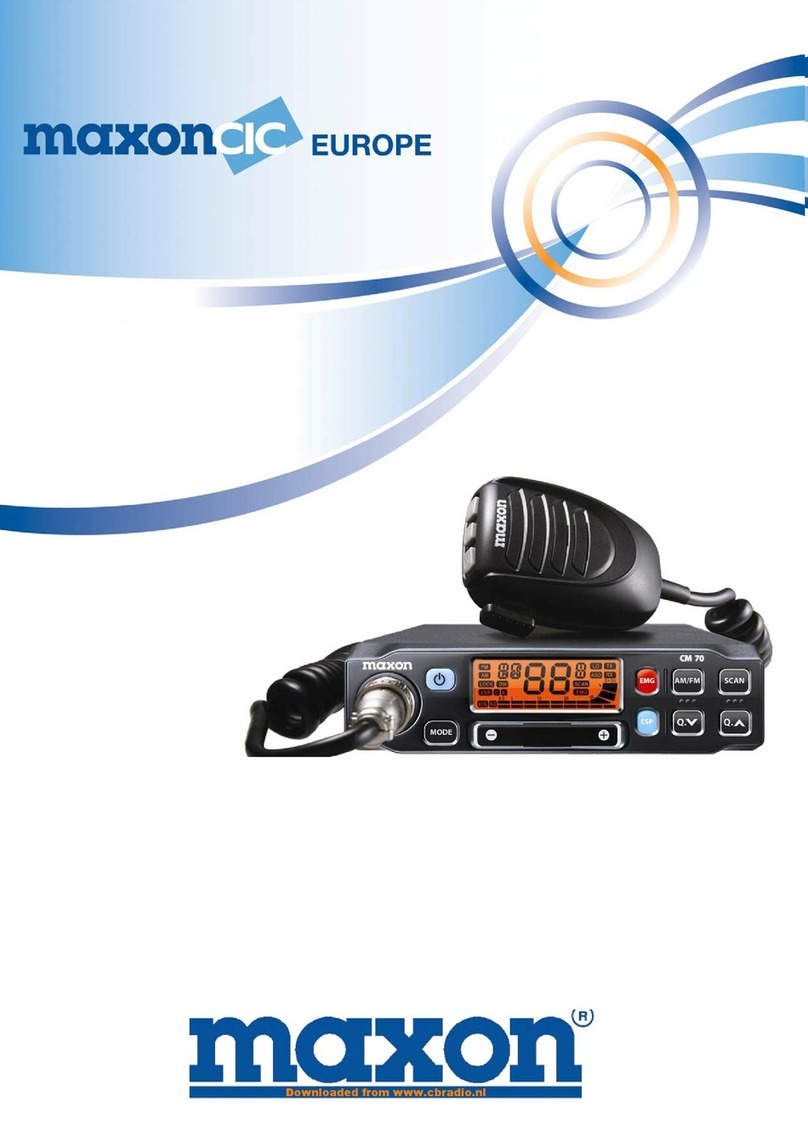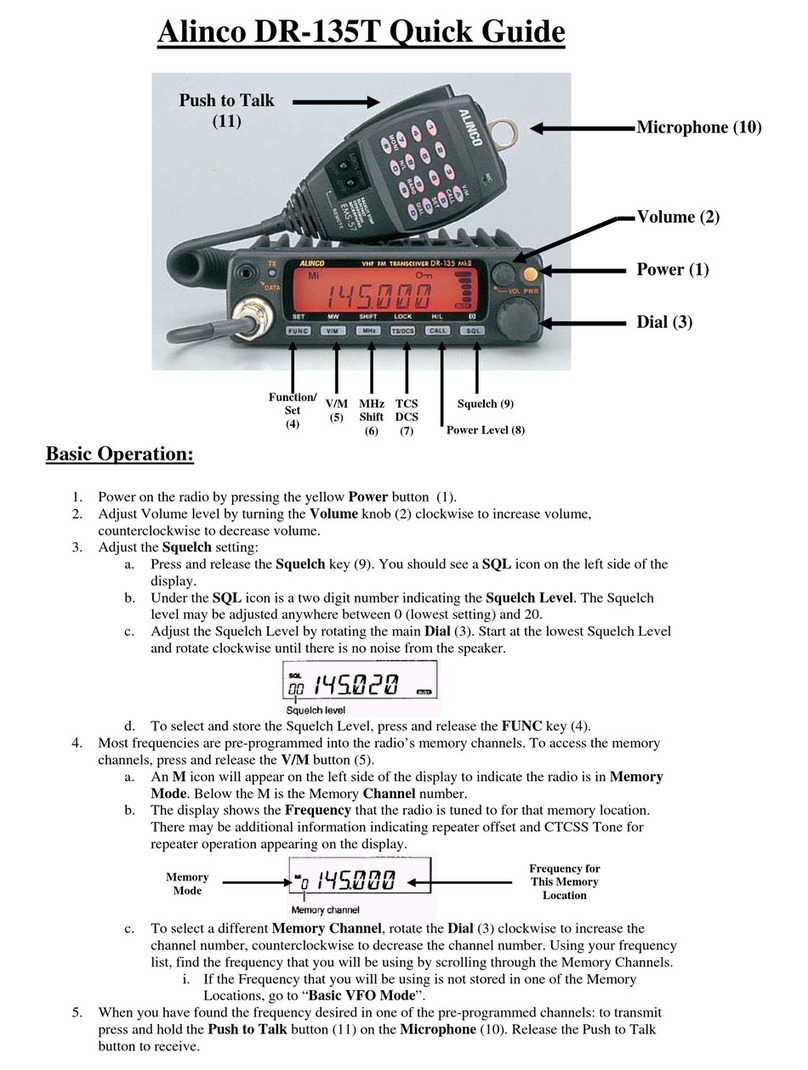TIL TAF-550 User manual

MODEL TAF-550
VHF/FM/AM MODULAR COMMUNICATIONS SYSTEM
THE MODEL TAF-550 INCLUDES THE FOLLOWING:
Model TFM-138B, FM Transceiver (138-174 MHz)
Model 91-DE, AM Transceiver (118-138 MHz)
Installation and
Operating Instructions
TiL Document No. 96RE187
Rev. D
JULY 2012
Technisonic Industries Limited
240 Traders Boulevard, Mississauga, Ontario L4Z 1W7
Tel: (905) 890-2113 Fax: (905) 890-5338
www.til.ca
Copyright by Technisonic Industries Limited. All rights reserved.


ii
REVISION HISTORY
[ 96RE187 ]
REV SECTION
- PAGE - DESCRIPTION DATE
Edited
by
n/c Original Document
A Global New Document Template (new file format)
Title page changed, Headers/Footers added
Added Revision page, Added Warranty page
The 10 channel (memories) will no longer be
available on all 91-DE based radios, ONLY 25.
3-9 Updated sect 3.4 for 10 & 25 channels MAR 2012 FM
B Sect 3.4
Update 25 channel memories as per doc #
96re202A TMS-150 opt 25 APR 2012 FM
C iii Updated FCC information including antenna and
FCC labeling instructions.
Simplify description under “Warning”
1.2.2 “7 Watt” changed to “Low Power”
1-6 Revise Transmitter Characteristics for FCC and
ICAN information JULY 2012 FM
D Clarified 10 / 25 channel description. JULY 2012 SM

iiii

iii
WARNING
Do not make physical contact with antenna when transmitter is on.
CAUTION ! STATIC SENSITIVE !
This unit contains static sensitive devices. Wear a grounded wrist strap and/or conductive gloves
when handling printed circuit boards.
FCC COMPLIANCE INFORMATION
This device complies with Part 15 of the FCC Rules. Operation is subject to the following two conditions:
(1) this device may not cause harmful interference and (2) this device must accept any interference
received, including interference that may cause undesired operation.
WARNING: For compliance with FCC RF Exposure Requirements the mobile transmitter
antenna installation shall comply with the following two conditions:
1.The transmitter antenna gain shall not exceed 3 dBi.
2. The transmitter antenna is required to be located outside of a vehicle and kept at a separation distance of 90 cm
or more between the transmitter antenna of this device and person(s) during operation.
NOTE: This equipment has been tested and found to comply with the limits for a Class A digital device,
pursuant to Part 15 of the FCC Rules. These limits are designed to provide reasonable protection against
harmful interference when the equipment is operated in a commercial environment. This equipment
generates, uses, and can radiate radio frequency energy and, if not installed and used in accordance with
the instruction manual, may cause harmful interference to radio communications. Operation of this
equipment in a residential area is likely to cause harmful interference, in which case the user will be
required to correct the interference at his/her own expense.
FCC LABELING INFORMATION: When this device is permanently mounted in an enclosure where the
FCC ID label can not be seen, another label must be placed on the outside of the enclosure stating
‘contains FCC ID: IMA90-6R’.
WARRANTY INFORMATION
The TAF-550 Communications System is under warranty for one year from date of purchase. Failed units
caused by defective parts, or workmanship should be returned to:
Technisonic Industries Limited
240 Traders Boulevard
Mississauga, Ontario L4Z 1W7
Tel: (905) 890-2113
Fax: (905) 890-5338

iv

TECHNISONIC INDUSTRIES LIMITED
www.til.ca
TAF-550 Installation & Operating Instructions TiL 96RE187 Rev D
v
TABLE OF CONTENTS
SECTION TITLE PAGE
SECTION 1 GENERAL DESCRIPTION
1.1 INTRODUCTION ............................................................................................................... 1-1
1.2 DESCRIPTION .................................................................................................................. 1-1
1.2.1 FM Transceiver Model TFM-138B, P/N 921012-1, Opt. B ................................................ 1-1
1.2.2 AM Transceiver Model Til-91-DE P/N 901006-1 ............................................................... 1-3
1.2.3 Modular Case P/N 953209-1 ............................................................................................. 1-3
1.2.4 Microphone P/N 961069-1 ................................................................................................ 1-3
1.2.5 DC Power Cable for 12V Supply P/N 963213-1 ............................................................... 1-3
1.3 MODES OF OPERATION ................................................................................................. 1-4
1.3.1 Transmit/Receive .............................................................................................................. 1-4
1.3.2 AC and DC Operation ....................................................................................................... 1-4
1.4 TECHNICAL SUMMARY .................................................................................................. 1-5
SECTION 2 PREPARATION FOR USE
2.1 INTRODUCTION ............................................................................................................... 2-1
2.1.1 Disassembly and cover removal ....................................................................................... 2-1
2.1.2 Removal of TFM-138B ...................................................................................................... 2-1
2.1.3 Removal of TiL-91-DE ....................................................................................................... 2-1
2.2 TFM-138B ADJUSTMENTS AND CUSTOM CONFIGURATION ..................................... 2-3
2.2.1 TFM-138B Wiring Connections ......................................................................................... 2-3
2.2.2 Internal Enable/Disable Jumper ........................................................................................ 2-3
2.2.3 Transmitter Power Adjustments ........................................................................................ 2-4
2.2.4 Transmitter Microphone level Adjustment ......................................................................... 2-4
2.2.5 Transmitter Sidetone level Adjustment ............................................................................. 2-6
2.2.6 Main and guard Squelch Adjustment ................................................................................ 2-6
2.2.7 Transmitter Deviation Adjustment ..................................................................................... 2-6
2.3 91-DE CUSTOM CONFIGURATION ................................................................................ 2-9
2.3.1 Fixed Channel Frequency Set Up ..................................................................................... 2-9
2.3.2 System Configuration ........................................................................................................ 2-9
2.3.3 Transceiver Removal ........................................................................................................ 2-9
2.3.4 Transceiver Disassembly and Jumper Installation ............................................................ 2-9
2.3.5 Transceiver Replacement ................................................................................................. 2-9
2.3.6 Operational Check ............................................................................................................ 2-9
SECTION 3 OPERATING INSTRUCTIONS
3.1 INTRODUCTION ............................................................................................................... 3-1
3.2 OPERATOR'S SWITCHES, CONTROLS AND INDICATORS ......................................... 3-1
3.3 GENERAL OPERATING INSTRUCTIONS ....................................................................... 3-6
3.3.1 Preparation for Use ........................................................................................................... 3-6
3.3.2 Transmitter Operation ....................................................................................................... 3-7
3.3.3 Receiver Operation ........................................................................................................... 3-8
3.3.4 Switching OFF ................................................................................................................... 3-8
3.4 FRONT PANEL KEYPAD OPERATION (10 or 25 Channel Memories) ........................... 3-9
3.4.1 Keypad "Beeps" ................................................................................................................ 3-10
3.4.2 Keypad and LCD Display Lighting .................................................................................... 3-10
3.4.3 Transmitter Time-out ......................................................................................................... 3-10
3.4.4 Selecting a Frequency ...................................................................................................... 3-11

TECHNISONIC INDUSTRIES LIMITED
www.til.ca
TAF-550 Installation & Operating Instructions TiL 96RE187 Rev D
vi
SECTION TITLE PAGE
(Section 3 - Continued)
3.4.5 Storing a Frequency to a Channel .................................................................................... 3-12
3.4.6 Recalling a Stored Channel .............................................................................................. 3-12
3.4.7 Transmit Inhibit .................................................................................................................. 3-13
3.4.8 Toggling Between Two Channels ..................................................................................... 3-13
3.4.9 Search Mode ..................................................................................................................... 3-14
3.4.10 Scan Mode ........................................................................................................................ 3-14
3.5 TFM-138B OPERATING FEATURES ............................................................................... 3-15
3.5.1 Operating Instructions ....................................................................................................... 3-15
3.5.2 Programming Instructions ................................................................................................. 3-17
3.5.3 Scanning Function ............................................................................................................ 3-18
3.5.4 Priority and Selective Scanning ........................................................................................ 3-19
3.5.5 Direct Frequency Entry Mode ........................................................................................... 3-19
3.5.6 Receive Frequency Simplex Function .............................................................................. 3-19
3.5.7 Keyboard Lockout Function .............................................................................................. 3-19
3.5.8 Variable frequency Mode Function ................................................................................... 3-20
3.5.9 LED Display Variable Dimming Mode ............................................................................... 3-20
3.5.10 90 Second Transmitter Time Out Feature ........................................................................ 3-20
3.5.11 Quick Guard Programming Feature .................................................................................. 3-20
3.5.12 Programming CTCSS Tones/DPL Codes ......................................................................... 3-20
3.5.13 PC Memory/Programming Download Capability ............................................................... 3-22
WARRANTY ..........................................................................................................................................
LIST OF FIGURES
FIGURE TITLE PAGE
1.1 Transceiver - General View (Closed & Open View) ................................................................. 1-2
2.1 TAF-550 Modular Comm System – Disassembly .................................................................... 2-2
2.2 Internal Enable/Disable Jumper and Tx Hi/Lo Power Adjust Locations ................................... 2-5
2.3 Microphone and Sidetone Level, Main and Guard Squelch Adjustment ................................. 2-7
2.4 Deviation Adjustment Potentiometer Location ......................................................................... 2-8
2.5 Fixed Channel Jumper Locations ............................................................................................. 2-10
3.1 TAF-550 Modular Communications - Set Up ........................................................................... 3-1
3.2 TAF-550 Front and Rear Panel Layout .................................................................................... 3-2
3.3 Operator’s Switches and Controls - TFM-138B ....................................................................... 3-16
3.4 TFM-138B PC Download Cable - Wiring Diagram ................................................................... 3-24
LIST OF TABLES
TABLE TITLE PAGE
1.1 TAF-550 Modular Comm System - Data Sheet ....................................................................... 1-5
2.1 TFM-138B Transceiver 15-Pin D Connections ........................................................................ 2-3
3.1 Operators Switches, Controls and Indicators ........................................................................... 3-3
3.2 Channel/Function Selector Keypad .......................................................................................... 3-9

TECHNISONIC INDUSTRIES LIMITED
www.til.ca
TAF-550 Installation & Operating Instructions TiL 96RE187 Rev D
1-1
SECTION 1 - GENERAL DESCRIPTION
1.1 INTRODUCTION
The Model TAF-550 Modular Communications System No. 960200, manufactured by Technisonic
Industries Limited, consisting of a VHF/FM and a VHF/AM Transceiver complete with an AC and
DC power supply, microphone and power cables. The TFM-138B is a frequency agile fully
synthesized FM transceiver offering an extended operating frequency range of 138-174 MHz with
selectable wide/narrow band channel spacing. The Model 91-DE is a microprocessor controlled,
simplex AM transceiver operating over the frequency range of 117.975 MHz to 138.000 MHz. The
Modular Communications system is intended for temporary, emergency or backup operation in a
fixed environment. The system can operate from external AC power, external 12 Volt DC power,
or external 24 Volt DC power.
1.2 DESCRIPTION
The TAF-550 Modular Communications System consists of FM Transceiver TFM-138B P/N
921012-1 Option B, AM Transceiver Model TiL 91-DE P/N 901006-2, Modular Case P/N 953209-
1, Microphone P/N 861902-1, AC Power Cord P/N 927002-1, DC cable Assembly P/N 963213-1
(12 Volt) and Optional DC Cable P/N 93212-1 (24 Volt). The rear panel access cover houses the
microphone, AC power cord, DC power cable assemblies and 2.5 Amp SLO blow fuse (AC), 5
Amp fuse (12 Volt DC) and 3 Amp fuse (24 Volt DC). Refer to Figure 1.1 for details.
1.2.1 FM Transceiver Model TFM-138B, P/N 921012-1, Opt. B
The TFM-138B, Transceiver is a frequency agile, fully synthesized airborne transceiver capable
of operating in the 138.000 MHz to 174.000 MHz frequency range in 2.5 kHz increments with
either 25 kHz or 12.5 kHz channel spacing. The Transceiver can operate without restriction on
any split frequency pair in the band and also incorporates a two channel synthesized guard
receiver.
The TFM-138B Transceiver provides 120 operator accessible memory positions, each of which is
capable of storing a transmit frequency, receive frequency, transmit frequency CTCSS tone or
DPL code, receive frequency CTCSS tone or DPL code, an alphanumeric identifier for each
channel and for wideband (25 kHz) or narrowband (12.5 kHz) channel spacing assignment.
Operating frequency and other related data are presented on a 48 character, two line LED matrix
display. Data entry and function control are performed via a 12 button keypad. Preset channels
may also be scrolled and scanned through keypad function activation. Data may also be entered
via an MS-DOS based computer with the provided software and optional PC download cable, P/N
943165-1. A DB-15 connector is provided on the rear panel of the TAF-550 chassis to facilitate
the PC download function of the TFM-138B without the need to remove it from the TAF-550
chassis.

TECHNISONIC INDUSTRIES LIMITED
www.til.ca
TAF-550 Installation & Operating Instructions TiL 96RE187 Rev D
1-2
Figure 1.1 TAF-550 Comm System - General View (Open & Closed View)

TECHNISONIC INDUSTRIES LIMITED
www.til.ca
TAF-550 Installation & Operating Instructions TiL 96RE187 Rev D
1-3
1.2.2 AM Transceiver Model TiL-91-DE, P/N 901006-2
The Transceiver is a microprocessor controlled VHF/AM transceiver operating over the entire
band of 117.975 to 138.000 MHz in 25 kHz steps. The transceiver will store 10 or 25 user
selected frequency channels in addition to the resident emergency channel of 121.500 MHz. The
TiL-91-DE transceiver was available in either 10 or 25 channel versions until July 2012. The 25
channel version can be identified by ‘25’ or ‘1283T’ on the option label on those units. All units
manufactured after July 2012 are 25 channel only. Frequency Selection, Storage, Recall,
Channel Scan, Search, and Toggle modes are all selected by the 12-key keypad. Current
operating frequency is displayed on a backlit liquid crystal display (LCD).
1.2.3 Modular Case P/N 953209-1
In addition to housing the two previously mentioned transceivers, the TAF-550 Modular case
consists of an AC to DC Power Supply Module, a DC to DC Power Supply Module and a speaker
for the TFM-138B.
1. AC to DC POWER SUPPLY MODULE - The AC Power Supply Module provides the 27.5
VDC supply voltage to the TFM-138B and 91-DE Transceivers, and houses a battery
charger which will provide a combination constant current constant voltage charging and
trickle charging to an optional external 24 Volt Battery connected to the DC connector (24
VDC output only).
2. DC to DC POWER SUPPLY MODULE - Provides the ability to power the TAF-550 with
an external 12 VDC supply. The dc to dc convertor steps the 12 VDC input to the
required 27.5 VDC to operate the TFM-138B and 91-DE Transceivers.
3. SPEAKER - With on/off switching function. Speaker will monitor the receive audio from
the TFM-138B. The speaker may also be switched off if a headset is used to access the
receive audio from the TAF-550 front panel phone connector. The 91-DE Transceiver
utilizes an internal speaker for this purpose.
The lower front panel of the TAF-550 Modular Case provides a main power on/off switch, a
transceiver backlighting on/off switch, a FM/AM transceiver selection switch, a PTT test button a
1/4" headphone connector and 0.2" microphone connector.
1.2.4 Microphone P/N 961069-1
The microphone is a rugged hand-held microphone housed in a high impact plastic case. The
dynamic microphone is a noise canceling type with a two-stage preamplifier, press to talk switch,
and a retractable three-core cable terminated by a standard 0.2" aviation jack which mates with
the MIC/PTT connector located on the front panel of the transceiver. The microphone dc supply
for the microphone is supplied by the transceiver. The microphone is stored in the rear access
compartment for transportation. A mounting hardware kit consisting of a microphone mounting
clip and clip mounting screws is also provided.
1.2.5 DC Power Cable for 12V Supply P/N 963213-1
DC Power Cable Part Number 963213-1 is provided with the TAF-550. This cable is configured to
allow operation with a 12 VDC supply. Pin 1 (12V input) and Pin 2 (ground) are wired on the
connector for this cable assembly. Optional 24V DC Power Cable P/N 963212-1 utilizes the same
connector but has Pin 2 (ground) and Pin 3 (24 V input) wired. The DC power cable is stored in
the rear panel access cover.

TECHNISONIC INDUSTRIES LIMITED
www.til.ca
TAF-550 Installation & Operating Instructions TiL 96RE187 Rev D
1-4
1.3 MODES OF OPERATION
The FM/AM selector switch located on the front panel of the TAF-550 is used to select operation
of either the TFM-138B FM Transceiver or the 91-DE AM Transceiver. The receive audio of the
selected transceiver will be routed over the headphone jack. Similarity the microphone connected
to the TAF-550 front panel will route transmit audio to the selected transceiver. Speaker Rx audio
for each transceiver can be manually turned on or off by the switch located under each speaker.
1.3.1 Transmit/Receive
Each transceiver may be operated in either of two modes; transmit or receive, as selected by the
Press-to-Talk (PTT) switch on the microphone.
(1) TRANSMIT MODE - When the PTT switch on the microphone is pressed, the transceiver
operates in the transmit mode. The PTT signal line is grounded by the microphone PTT
switch via the microphone lead and the MIC/PTT connector to the transceiver.
On the TFM-138B either a “TX” or “TT” will be shown after the frequency on the
alphanumeric LED display. A “TT” rather than a “TX” indicates that either a transmit
CTCSS tone or DPL code has been programmed.
For the 91-DE the Tx ON amber LED will go ON, indicating that the transmitter is
activated. Transmission will occur on the channel frequency displayed on the Liquid
Crystal Display (LCD). Frequency is determined by keypad entry of the operating
frequency or by recalling a stored channel.
(2) RECEIVE MODE - When the PTT switch on the microphone is released, the transceiver
operates in the receive mode.
On the TFM-138B either a “RX” or “RT” will be shown after the frequency on the
alphanumeric LED display. A “RT” as opposed to an “RX” means that a receive CTCSS
tone or DPL code has been programmed.
In the receive mode on the 91-DE the Tx ON amber LED will go OFF, indicating that the
transmitter is inhibited. Reception of the frequency displayed on the LCD will occur.
For the 91-DE the setting of the SQUELCH CONTROL determines the squelch threshold
level. When the SQUELCH CONTROL is rotated in the counter-clockwise direction, the
SQUELCH INDICATOR green LED will go ON, indicating that the squelch circuit is
connecting the demodulated audio to the VOLUME CONTROL. The setting of the
VOLUME CONTROL determines the audio level produced from the internal speaker.
When the VOLUME CONTROL is adjusted in the clockwise direction, the audio level will
increase.
The TFM-138B main and guard receiver squelch settings are located on the bottom panel
of the TFM-138B chassis. The TFM-138B squelch is factory set to 0.5uV.
1.3.2 AC and DC Operation
The unit can be operated by external 120 VAC, external 28 VDC, or external 12 VDC power.
1. AC OPERATION - An AC power cord P/N 927002-1 is supplied in the rear access cover
of the portable case assembly. During AC operation, the operator can elect to trickle
charge external batteries (24 V only) when connected to the DC connector configured for
24 Volts.
2. DC OPERATION - The unit can be operated from an external 24V DC supply within the
range of 21.6 VDC to 30 VDC. A DC connector is mounted on the rear of the Modular
Chassis which mates with DC Power Cable P/N 963212-1 (Not Supplied) to facilitate
external DC operation. DC Power Cable P/N 963213-1 will allow operation with a 12V DC
external input supply and is included with The TAF-550 System.

TECHNISONIC INDUSTRIES LIMITED
www.til.ca
TAF-550 Installation & Operating Instructions TiL 96RE187 Rev D
1-5
1.4 TECHNICAL SUMMARY
A summary of electrical, operational, mechanical and physical characteristics of the transceivers,
modular case and microphone indicated in Tables 1.1.
TABLE 1.1 TAF-550 MODULAR COMM SYSTEM - DATA SHEET
GENERAL:
Power Requirements:
AC Input Voltage/Current …………………………………………..….. 100 to 132 VAC @ 1.5 Amp
DC Input Voltage/Current (24V configuration ……………….... 2)1.6 VDC to 30 VDC @ 2.5 Amp
DC Input Voltage/Current (12V configuration) ….……………..... 1.6 VDC to 13 VDC @ 4.5 Amp
Frequency Range, TFM-138B (FM) ………………………….………………….. 138.000 to 174.000 MHz
Number of Channels (TFM-138B) ………………………….….... (120) programmable memory positions
Frequency Range, 91-DE (AM) ………………………………………………….. 117.975 to 138.000 MHz
Number of Channels (91-DE) ……………………………………………………………….. Ten (10) preset
Temperature & Humidity:
Operating Temperature Range ………………………………..….. -25°C(-13°F) to +55°C(+131°F)
Storage Temperature Range ………………………………….…... -55°C(-67°F) to +65°C(+149°F)
Relative Humidity ……………………………………………………………... 100% non-condensing
Microphone Compression Range ……………………….…….………………………………... 35 dB
Antenna:
Impedance ……………………………………………….…………………….…………..…..….. 50
VSWR …………………………………………………………….…………….…………..….. 4:1 MAX
Dimensions & Weight (excluding Front and Rear Covers):
Width X Height X Depth ……………………………………………….... 10.0 X 8.75 X 14.0 in MAX
Weight ……………………………………………………………………………………..... 16 lbs MAX
MODEL TFM-138B TRANSCEIVER:
TRANSMITTER:
RF Power Output …………………………….………………………………………….. 1 or 10 Watts
Output Impedance …………………………..…………………………………………….….. 50 ohms
Maximum Deviation …………………….….. ±5 kHz (25 kHz mode) or ±2.5 kHz (12.5 kHz mode)
Spurious Attenuation …………………..………………………………….…….. -90 dB below carrier
Frequency Stability (-20°C to +55°C) …….……………………………………….... ±0.0005% MAX
Microphone Circuit …………………………..………………………………..... Carbon or equivalent
Sidetone Output ……………………………..…………………………... 0.5W (max) into 600 ohms
Harmonic Attenuation ……………………..…………………………………….. -65dB below carrier
FM Hum and Noise ………………………..…………………………………..... -40 dB below carrier
Audio Input …...... 50 millivolts at 2.5kHz into 200 ohm input circuit for ±3.5kHz deviation, adjst.
Audio Distortion ……………………………………………………………………….……..... 5% MAX
MAIN RECEIVER:
Sensitivity (12 dB SINAD) ………………………………………………….... better than 0.35 μvolts
Adjacent Channel Selectivity
25 kHz Channel Spacing ………….………………………………………………….... -70dB
12.5 kHz Channel Spacing …………………………………………………………….. -70dB
Spurious Attenuation …………………………………………………………………………….. -90dB
Third Order Intermodulation …………………………………………………………………….. -70dB
Image Attenuation …………………………………………………………………………….….. -80dB
FM Acceptance …………………………………………………………………………………... ±6kHz
Hum & Noise ……………………………………………………………………………….... 50 dB MIN
Antenna Conducted Emission ………………………………………………………….. -70 dBm MIN
GUARD RECEIVER: All specifications identical to main receiver

TECHNISONIC INDUSTRIES LIMITED
www.til.ca
TAF-550 Installation & Operating Instructions TiL 96RE187 Rev D
1-6
TABLE 1.1 TAF-550 MODULAR COMM SYSTEM - DATA SHEET (Continued)
MODEL 91-DE, TRANSCEIVER
TRANSMITTER:
*Power Output (FCC) ..............................................…………………………...…… 10 Watts MAX
*Power Output (ICAN) …………………………………………………………………… 8 Watts MAX
Frequency Stability (-40EC to +55EC) ………………………………………….... ±0.00025% MAX
Audio Input …………………………………………………………………….. 0.05 Vrms to 2.0 Vrms
Speech Processor Dynamic Range ………………………………………………………….... 35 dB
Modulation ………………………………………………………………………………….... 95% MAX
Audio Distortion @ 90% mod (Low Power) …………………………………………….... 10% MAX
Audio Distortion @ 90% mod (High Power) …………………………………………….... 15% MAX
Audio Frequency Response ……………………………………….... 300 Hz to 2,500 Hz, +1 -3 dB
Spurious Emissions …………………………………………………………….... 60 dB below carrier
Hum and Noise ……………………………………………………... 45 dB below modulated carrier
RECEIVER:
RF Input Impedance ………………………………………………………..….. 50S, VSWR 2:1 MAX
Sensitivity (12 dB SINAD) @ 1 KHz 30% Mod ………………………………………..….. 1.5 μvolts
Selectivity, 25 KHz Channel Spacing:
6 dB Bandwidth ……………………………………………………….. Greater Than 14 KHz
90 dB Bandwidth ……………………………………………………….... Less Than 50 KHz
Adjacent Channel Selectivity …………………………………………………... Greater Than 90 dB
Spurious Response Attenuation …………………………………………….….. Greater than 95 dB
Frequency Stability (-40°C to +55°C) …………………………………………….. ±0.00025% MAX
RF AGC (5 μvolts to 1 volt) …………………………………………………….….. Audio Level 3 dB
Intermodulation:
Ultimate Sensitivity ……………………………………………………………………………….. 70 dB
30 μvolts …………………………………………………………………………………………... 45 dB
Unwanted Radiation ………………………………………………….. Less than 80 μvolts into 50
Hum & Noise @ 1mV RF 30% MOD ……………………………………………………... 40 dB MIN
Interference Suppression …………………………………………………………... SINAD 6 dB MIN
Loudspeaker Output ………………………………………………………………... 3 W MAX
Phone Output ………………………………………………………….... 100 mW into 600
Audio Distortion 1mV RF Input, 30% MOD ……………………………………….. 3% MAX
Audio Distortion 1mV RF Input, 90% MOD ……………………………………………….... 6% MAX
Audio Output Limiting ………………………………………….. Less than 1 dB @30 to 100% MOD
Audio Frequency Response 300 Hz-2500 Hz …………………………………………….... +1 -3 dB
Audio Acquisition Time ……………………………………………………….... Less than 100 msecs
Audio Squelch Characteristics:
Squelch Type ………………………………………………... Signal-to-Noise and Carrier Operated
Carrier Operated Squelch ………………………………….. Front Panel Adjustable 2 to 15 μvolts
Signal-to-Noise Squelch ……………………………….... Internally Adjustable up to 15 dB S+N/N

TECHNISONIC INDUSTRIES LIMITED
www.til.ca
TAF-550 Installation & Operating Instructions TiL 96RE187 Rev D
2-1
SECTION 2 – PREPARATION FOR USE
2.1 INTRODUCTION
This section provides the information required for the removal, replacement, adjustment and/ or
custom configuration of the self-contained modular TFM-138B and 91-DE Transceivers.
Custom configuration and adjustments on the TFM-138B include; Internal enable/disable Jumper
selection, Tx power adjustment, Tx microphone level adjustment, Tx side tone level adjustment,
Main and Guard squelch adjustment and Transmitter deviation adjustment. Custom configuration
for the 91-DE Transceiver includes customizing channel frequencies. Channels 0 to 9 can be
configured for fixed frequency operation including transmit inhibit on pres-elected channels.
2.1.1 Disassembly and cover removal (Refer Figure 2.1)
(1) Release the (4) clip fasteners securing each front and back cover.
(2) Remove and retain (4) bottom screws and (4) top screws securing cover to chassis.
(3) Remove and retain (4) screws on each side securing cover to chassis, then slide the
cover forward and lift it clear of the chassis.
(4) Reverse the order of the above steps to replace the cover on the TAF-550 chassis.
2.1.2 Removal of TFM-138B)
(1) Remove TAF-550 cover as described above and then release the (4) Dzus rail mounting
screws on the front panel of the TFM-138B.
(2) Remove the BNC RF connection from the back of the TFM-138B and then slide it out
approximately 3 inches forward through the front cut-out of the TAF-550 chassis.
(3) Undo the (2) slotted screws securing the DB-9 connector on the back of the TFM-138B
and slide the unit out of the TAF-550 chassis front cut-out.
(4) Reverse the order of the above steps to re-install the TFM-138B Transceiver.
2.1.3 Removal of the TiL-91-DE
(1) Remove the TAF-550 cover and the TFM-138B as described in the previous paragraphs.
Remove the two large mounting screws securing each side of the 91-DE Transceiver.
(2) Disconnect the two screws securing the DB-9 remote connector on the right side of the
91-DE Transceiver. Remove the DB-9 connector and pull the 91-DE Transceiver
approximately 1 inch through the front cut-out of the TAF-550 chassis.
(3) Remove the DC and UHF RF connectors located on the back of the 91-DE chassis.
(4) Slide the 91-DE chassis back through the TAF-550 front cut-out and lift up and out of the
back of the TAF-550 chassis.
(5) Reverse the order of the above steps to re-install the TiL-91-DE Transceiver in the TAF-
550 modular chassis.

TECHNISONIC INDUSTRIES LIMITED
www.til.ca
TAF-550 Installation & Operating Instructions TiL 96RE187 Rev D
2-2
Figure 2.1 TAF-550 Modular Comm System - Disassembly

TECHNISONIC INDUSTRIES LIMITED
www.til.ca
TAF-550 Installation & Operating Instructions TiL 96RE187 Rev D
2-3
2.2 TFM-138B ADJUSTMENTS AND CUSTOM CONFIGURATION
Custom configuration and adjustments on the TFM-138B include; Internal enable/disable Jumper
selection, Transmitter power adjustment, Transmitter microphone level adjustment, Transmitter
side tone level adjustment, Main and Guard squelch adjustment and Transmitter deviation
adjustment. The TFM-138B wiring connections are also provided.
2.2.1 TFM-138B Wiring Connections
The TFM-138B Transceiver’s 15 Pin D connector is prewired for use in the TAF-550 chassis. The
following table provides the input/output signal information for each pin of this connector. The pins
numbers are stamped on the connector located on the back panel of the TFM-138B.
TABLE 2.1 TFM-138B Transceiver 15-Pin D Connections
Pin # Description Pin # Description
1 600 Ohm Output 9 4 ohm Speaker Output
2 Data Output 10 4 ohm/600 ohm Output Ground
3 Panel Lighting (28VDC or 5VAC) 11 Data Input
4 Memory UP/PC Download Input 12 PC Download Input
5 Memory Down/PC Download Input 13 PTT (Ground Keying)
6 Mic Signal Input 14 Main Power +28VDC
7 Main Power +28VDC 15 Main Ground
8 Main Ground
2.2.2 Internal Enable/Disable Jumper
The programming and direct frequency entry modes can be disabled by removing the internal
enable/disable jumper. Removal of this jumper will prevent operation on any frequencies other
than those programmed in the 120 memory positions and two guard receiver memory positions.
The TFM-138B transceiver is always shipped with this jumper in the entry enable position. To
place the jumper in the disable position, remove the TFM-138B from the TAF-550 chassis and:
(1) Remove and retain the seven (7) No. 4-40 screws securing the bottom cover of the
transceiver to its chassis.
(2) Remove and retain the four (4) No. 4-40 screws securing the guard receiver PCB module
in the chassis tray. Remove the guard receiver module from the chassis tray.
(3) Remove and retain the two (2) screws securing the fuse board. Remove and retain the
five (5) screws securing the chassis tray to the main chassis. Remove the chassis tray.
(4) You should now have access to the Microprocessor Control Unit (MCU) PCB Module
(See Figure 22). Remove the enable/disable jumper from pins 3 and 4 of J15.
(5) Reverse steps 1 through 3 and secure all screws to re-assemble the transceiver.

TECHNISONIC INDUSTRIES LIMITED
www.til.ca
TAF-550 Installation & Operating Instructions TiL 96RE187 Rev D
2-4
2.2.3 Transmitter Power Adjustments
The transmitter power is adjusted to a maximum of 10 watts in high power mode and 1 watt in low
power mode over the transceiver operating bandwidth at the factory. If transmitter RF power re-
adjustment is required, perform as follows:
(1) Remove bottom cover as described in the previous paragraph (2.2.2). Access to the two
adjustment potentiometers on the Microprocessor Control Unit (MCU) PCB Module is
provided by two access holes located at the back of the chassis tray.
(2) Connect an RF through-line wattmeter to the antenna connector. Set the operating
frequency to 156.000 MHz and key the transmitter.
(3) In low power mode, set the low power adjustment potentiometer R24 to produce 1.0 watt
of RF output power (See Figure 2.2).
(4) In high power mode, set high power adjustment potentiometer R23 to produce 9.5 watts
of RF output power.
(5) Verify that the RF output power is between 9 and 10 watts on 138.000 MHz, 162.000
MHz and 174.000 MHz.
(6) Replace bottom cover as described in the previous paragraph (2.2.2).
2.2.4 Transmitter Microphone Level Adjustment
(1) Set the transceiver operating frequency to 156.000 MHz and connect an appropriate test
receiver to the RF output connector. Ensure that the output of the transceiver is
terminated into a proper dummy load.
(2) Key the transmitter and input a -10 dBm (0.25 VRMS), 1 KHz audio signal into the
microphone input.
(3) Adjust the microphone level potentiometer (R8 on MCU module) through the access hole
located on the right side of the chassis (see Figure 3-4) to produce a 3.5 KHz deviation.
(4) Verify that the deviation is at least 3 KHz on the following frequencies: 138.000 MHz,
162.000 MHz and 174.000 MHz.

TECHNISONIC INDUSTRIES LIMITED
www.til.ca
TAF-550 Installation & Operating Instructions TiL 96RE187 Rev D
2-5
Figure 2.2 Internal Enable/Disable Jumper and Transmit High/Low Power Adjust Locations

TECHNISONIC INDUSTRIES LIMITED
www.til.ca
TAF-550 Installation & Operating Instructions TiL 96RE187 Rev D
2-6
2.2.5 Transmitter Sidetone Level Adjustment
(1) Set the transceiver operating frequency to 156.000 MHz and connect an appropriate test
receiver to the RF output connector. Ensure that the output of the transceiver is
terminated into a proper dummy load.
(2) Key the transmitter and input a -10 dBm (0.25 VRMS), 1 kHz audio signal into the
microphone input.
(3) Adjust the sidetone level potentiometer (R37 on MCU module) through the access hole
located on the left side of the chassis (see Figure 2.3) to produce a +3.0 dBm (1.0
VRMS) 600 ohm audio output.
2.2.6 Main And Guard Squelch Adjustment
The squelch on both the main and guard receivers is factory set to open at approximately 0.5
microvolts. This adjustment can be made or altered to suit local conditions as follows:
(1) Set the main receiver of the transceiver to 156.0 MHz. Connect a signal generator the
antenna input of the transceiver.
(2) Set the signal generator to produce a ±3 kHz deviation with a 1 kHz tone on 156.000
MHz.Increase the signal generator RF level from 0.1 uV until the squelch indicator LED is
on. Verify the receiver SINAD ratio is between 12 and 14 dB.
(3) If not, re-adjust main receiver squelch potentiometer, R3 through the access hole located
on the bottom of the transceiver chassis (see Figure 2.3).
(4) Repeat the above procedure to adjust the guard receiver squelch setting using guard
receiver squelch adjustment potentiometer, R4 (see Figure 2.3).
2.2.7 Transmitter Deviation Adjustment
(1) Remove and retain the eight (8) No. 4-40 screws securing the top cover of the
transceiver to its chassis. You should now have access to the Main Rx/Tx Module.
(2) Set the transceiver operating frequency to 156.000 MHz and connect an appropriate test
receiver to the RF output connector. Ensure that the output of the transceiver is
terminated into a proper dummy load.
(3) Key the transmitter and input a +10 dBm (2.5 VRMS), 1 kHz audio signal into the
microphone input.
(4) Adjust the wideband deviation limit potentiometer, R30 on the main Rx/Tx module (see
Figure 2.4) to produce a ±4.45 kHz deviation. For TFM-138B only: Adjust the narrowband
deviation limit potentiometer, R76 on the main Rx/Tx module to produce a ±2.2 kHz
deviation. (All narrowband adjustments for TFM-138B only).
(5) Verify that the deviation does not exceed ±5 kHz for wideband and ±2.5 kHz for
narrowband on the following frequencies: 138.000 MHz, 162.000 MHz and 174.000 MHz.
Re-adjust R30 or R76 as required, if the deviation exceeds ±5 kHz or ±2.5 kHz,
respectively.
(6) Place top cover on transceiver chassis and secure all eight (8) screws.
This manual suits for next models
2
Table of contents
Other TIL Transceiver manuals
